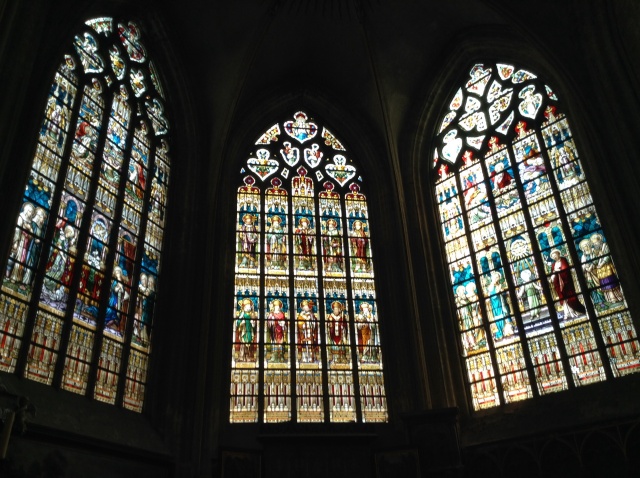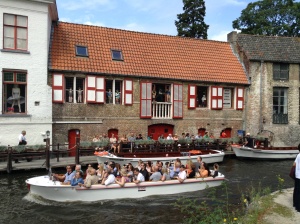I will be going on my second week of summer vacation soon. Saturday morning I fly to Seville, from there, two days later, I’ll be going to Cordoba, then back to Seville via Granada, where I’ll also be spending 2 days. A bit rushed, as was my Italian getaway, but there’s only that much ground one can cover in 7 days. I’m hoping for sunshine to counterbalance the miserable weather we’ve been having in Paris: rain, rain and more rain.
But first, just so I don’t forget it, the customary 24 hour in Denmark.
Wish me luck.
Monthly Archives: August 2014
The truth about work life balance in France
In North America, the general fascination with Europe centres around differences in lifestyle and societal approach to life-work balance between the European and American/Canadian society.
Moreover, the reference case for such comparisons and the corollary of North American envy is France. A visit to any bookstore would inevitably lead to the dedicated corner to everything French, where in the smallest of spaces one can see a plethora of books on the broadest variety of topics relating to France and the French. The title is always prosaic and message invariably positive. Paris, the most romantic city; French food paradox: eat butter, drink wine, live happy and long! French men are great lovers! French women don’t diet! The French work 35 hours a week and enjoy the longest holidays in Europe!
Oh, let’s all move to Paris, let loose and be French!
..well, I did. Not because of those books, incidentally, and not because I believed all the hype but, truthfully, because I needed a change and was hoping for a slightly more relaxed life, with bit more time to travel and more time to myself.
Fast-forward a year and I’m sitting admiring Parisian rooftops from my apartment, paid for with the wages from my enviable Parisian job. Friends back in North America imagine me breakfasting on fresh croissants and accompanying each meal with champagne, while strolling carefree the bohemian Paris quartiers.
But the reality is this: right now in front of me I have my work laptop, and a presentation that I’m working on …on Saturday. I spent my whole day working today and I’ll be working tomorrow, too.
Monday to Friday I work from 9-9:30 to 6:30- 7, and that’s a regular day. All my French colleagues work like this. Yes, we are given 6 weeks of vacation, but that’s to compensate 46 weeks of 10-11 hour days.
How is this possible? It’s simple. France operates on a dual band workforce: those working for one type of government job or another, benefiting from long vacations (8-9 weeks) and the prescribed 35 hour week but receiving very small wages; and those working for the corporations as “cadre” … who have to opt out of the 35 hour week, work like dogs and, to compensate, have a decent wage, 5 or 6 weeks of vacation and 5-6 additional RTT (reduction du temps de travail) days off a year. For the latter, 50 – 60 hours, plus more than the occassional weekend of unpaid work, is the norm.
If you’re dreaming of moving to France in search of that easy life, think again. As an expat, you’ll only be able to get a job as a cadre. So, unless you’re independently wealthy, your simple, stress-free life in Paris will remain a dream if you come here with a job.
The 9-5 is an Anglo-Saxon concept that is not adopted here. It’s strange to me, but all my colleagues at work are jealous of my former 9-5 life in Canada….in fact, many dream of moving to Montreal. I have days when I, too, get nostalgic for what, at the time, seemed a very stressful work schedule.
You don’t have to take my word, feel free to check out some related articles about work life balance in contemporary Europe….
http://www.reuters.com/article/2013/07/31/us-france-workhours-idUSBRE96U13820130731
http://www.bbc.com/capital/story/20140312-frances-mythic-35-hour-week
Not quite the stuff of dreams, is it?
Truth is, my job enables me to run around Europe at the weekends (when I don’t work) and for that, I am grateful.
But the reality of my work in Paris has killed every preconceived idea on the French life/work balance I might once have had…
Arles – the little Rome of Provence
Affectionately known as “little Rome”, Arles was established as the first Roman foundation in Gaul. The 26,000-seat Les Arènes d’Arles (another UNESCO heritage site) was originally built for circuses and gladiator combats towards the end of the 1st century B.C. Still in use, it is now the site of Sunday afternoon bullfights. I know, who would have thought bullfights take place outside of Spain? In fact, both Nimes and Arles have them, owing the taste for the fight to the proximity of this part of Provence to Spain. The Provençal version of the sport, however, puts a more humane spin on the game, as the animal does not get killed. Instead, Bulfighters have to retrieve a rosette tied to the animal’s forehead without being gored.
Beyond the Arene, the Théâtre Antique (site of a Music and Drama Festival each July), is even more magnificent. Endowed with amazing acoustics, though quite affected by the passage of time, the theatre astounds and humbles, and takes one to Ancient Greece via the Romans.
More Roman vestiges can be found on the banks of the River Rhone, in the Thermes de Constantin. Originating from the 4th century AD, the thermal baths are incredibly well preserved, and quite instructional: the rooms and heating mechanism are well preserved and speak to an ingenious and precocious mastery of technology.
St Trophime Church, finally, is also a must, but, on this occasion was closed for an event. I did, however, get a chance to visit the pretty and serene cloisters.
All in all, Arles is truly enchanting. For fans of Van Gogh, there are numerous traces of his time in the city as well as dedicated museums. For me, that would have to wait for a return trip.
In Nimes – Roman ruins, French charm and birthplace of jeans
I’m back in Provence, having come in to soak in the sun for the long week-end. Nimes was an easy choice: it is the Roman town in France and sister-town to Verona. Nimes had been constructed in Roman times and is home to a wealth of well preserved Roman ruins. The charming and impressive Arene de Nimes, a small coliseum still in use today, and the beautiful temple called Maison Carree transport one to a glorious era of Gods, emperors and gladiators. Incidentally, the movie Gladiator was shot here and the arena appears in the fight scenes.
La Maison Carree, on the other hand, is remarkable for reportedly being the most intact Roman temple in existence. Dating from around year 2 AD, it was constructed as a replica to the Temple of Apollo in Rome by emperor Augustus, when Nimes, then called Nemasus, was a prominent colony.
In medieval times, Nimes became a famous textile manufacturing centre. What most people, including me, would be surprised to hear is that it is here that denim (de Nimes!) was invented! The fabric was then exported to Europe and, later, America, via Genes (Genova), which, mispronounced, perpetuated another name for it, “jeans”! Who knew?
The town, finally, has the typical southern European feel: narrow streets, lively piazzas, sunny weather.
The medieval tower in Place d’Horologe changes colour at night, people eat dinner late into the night, German tourists get serenaded by Gypsy bands and everyone enjoys the balmy evenings and relaxed atmosphere of the town.
Guess where I am now?
72 Hours in Purgatory (AKA Bruges)
Someone dared spend 72 hours in Bruges! I laughed so much reading this.
The Idiot’s Guide to Thrift Tripping
“After I killed him, I dropped the gun in the Thames, washed the residue off me hands in the bathroom of a Burger King, and walked home to await instructions. Shortly thereafter the instructions came through – ‘Get the fuck out of London, you dumb fucks. Get to Bruges.’ I didn’t even know where Bruges fucking was…It’s in Belgium…Maybe that’s what hell is, the entire rest of eternity spent in fucking Bruges.” ~ Ray (Colin Farrell) in In Bruges
Bruges is one of the most boring places you could ever hope to spend 72 hours in.
Just to give you an idea of how boring Bruges is…if you google “things to do in bruges,” the first result you’ll get is Trip Advisor’s list of a staggering 47 activities, most of which are architectural buildings that you will be admiring from the outside. Activity #1 is to walk around the…
View original post 1,797 more words
48 hours in Bruges
Bruges, I have concluded, is best seen in one day. The morning can be spent getting lost around the narrow streets (a very easy task); lunchtime can provide a respite accompanied by beer, while the afternoon is best spent visiting the churches, walking alongside the canals, or sampling the local taste trinity: waffles, chocolate and more beer.
I did all this and more, since I had 48 hours in Bruges.

To be fair, this is a pretty town. It is, however, quite lacking in serious cultural entertainment, unless your travel interest include the history of chocolate, fries and beer, as all these have dedicated museums. Much as I enjoy all those food items, however, my interest in them does not go beyond the tasting, so, I didn’t go to visit any of those museums.
I did go to see the churches, though, I simply had to. The Church of Our Lady, for one, is a must on any art lover’s itinerary, as it houses the only statue of Michelangelo in its intended location (i.e., not in a museum) outside of Italy. His Madonna is believed to have been meant for the Sienna Cathedral, but was insteaad bought by two merchants from Bruges and donated to the city in 1504.
The Bruges Cathedral, on the other hand, called St Salvator’s Church, is not home to world renowned treasures, but has the most impressive stained glass windows’ I’ve ever seen. Unfortunately, both churches are currently undergoing extensive renovation, which dampens the experience a little.
Other than that, I spent the rest of my time walking the narrow streets and wandering alongside the canals.
I did like Bruges, overall, but I think its loving nickname, the Venice of the North, is a huge exaggeration! Bruges, to me, is a town to visit after you have run out of other beautiful European towns and cities to visit. As is, indeed, Belgium.
Go in for the beer, enjoy the waffles, buy handmade chocolate and take your photos, by all means. But don’t go to Bruges expecting anything like Venice, or you’ll be rather disappointed.
For the love of beer
Bruges, like all of Belgium, has an impressive number of beer houses, terraces and shops. Also, the Wall of Beer is a shrine to the product, in manner of Verona’s (fictitious) house of Juliet.
These beers are brewed strong (7-8%) which, judging by the merriment of some tourists, is not always advertised. There is also fruit beer available, kinder on the liver at 2-3% and super-tasty.
In Bruges…not the movie
I used to be one of those travellers who research the places they are planning to visit, learn about the place and get there knowing quite a bit and certainly knowing what to expect. Sadly, that was before, when I had another job and, in retrospect, far more time for myself.
So, this week-ends’ destination, Bruges, was selected on the basis of some positive reviews from colleagues at work, and the fact that it is a UNESCO heritage site.
I came here by train (the elegant Thalys) in first class with breakfast being served on the way… good sign! I read a bit about the town on the train… mixed reviews. The film, which I’d never seen, apparently portrays Bruges as a sh*^%*le… not good! Oh well, I’ll see for myself!
I got into Bruges around 11, checked into the hotel, dropped my luggage and started into town. The sky was a bit cloudy but not too bad. To walk into town coming from the station I was advised to go through the park. However, I chose to take a street, instead, to get a more immediate feel for the place.
It started innocently enough, with some pretty Inns and B&Bs…and then I turned a corner and I got this Copenhagen feeling!!! And not in a good way. Bruges, it turns out, is an unspoilt medieval town, preserving most of its architecture from its heyday period, the 1500s, when it was a prosperous trading centre. More importantly, though pre-dating the Roman invasion, Bruges established itself in the 9th century, upon the descent of the Vikings.
So, you can understand how joyous my feeling when I realised Bruges is a mini-Copenhagen!!! Same type of red-brick architecture, similar layout of market places and squares, same…air as my beloved Copenhagen.

Later in the day I had the opportunity to get to the more famous landmarks, the Markt, a beautiful square, the imposing St Salvator Church, the postcard worthy Minnewasser, the so-called Lake of Love.

Bruges is quite pretty, not at all ‘the epicentre of northern European dullness’, as the Guardian article reviewing the film ‘In Bruges’ described it(filling me with horrified anticipation). I’ll see more tomorrow and I’m sure I won’t be displeased but, nonetheless, I decided today to only take the train south of Paris from now on….At least while I have this job and my acquired Copenhagenphobia!





































